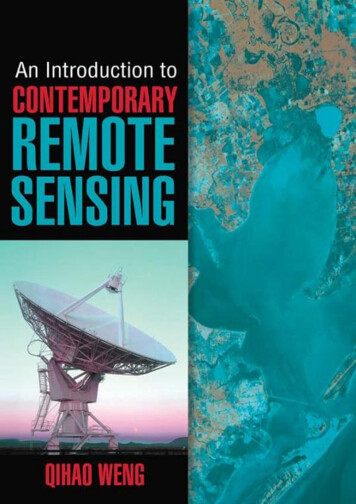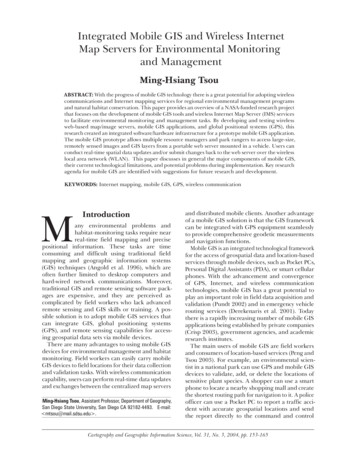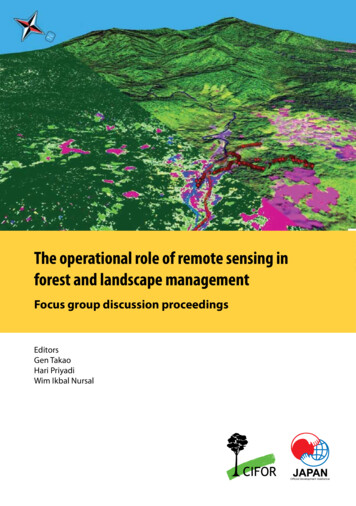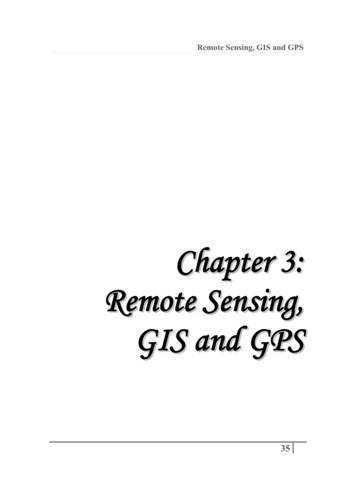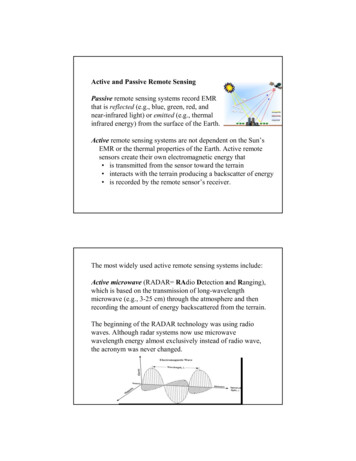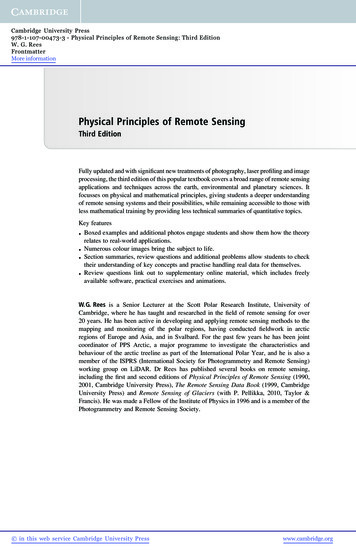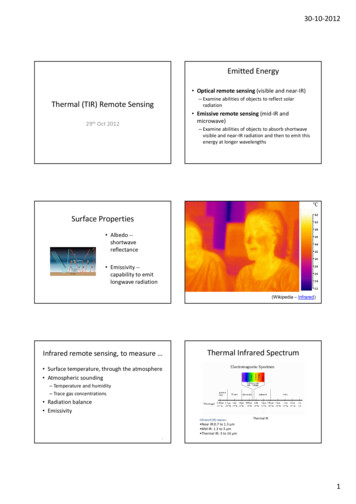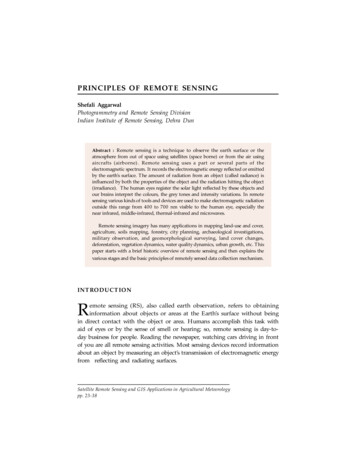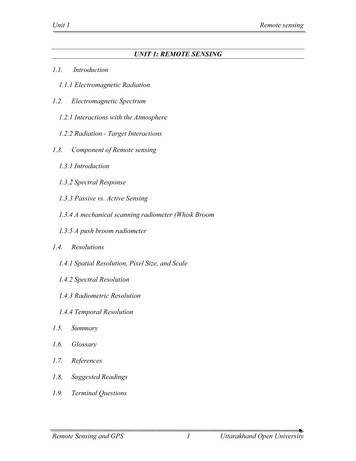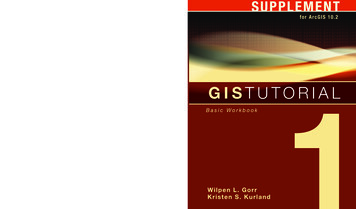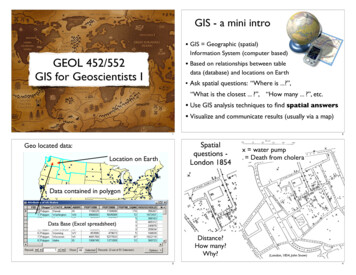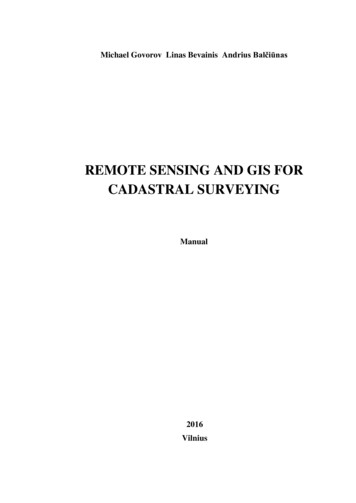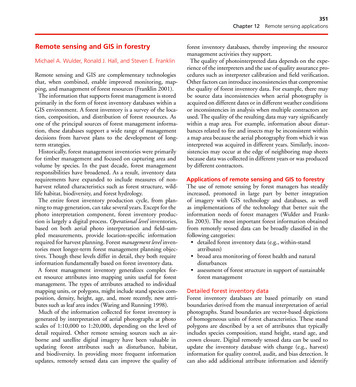
Transcription
351Chapter 12 Remote sensing applicationsRemote sensing and GIS in forestryMichael A. Wulder, Ronald J. Hall, and Steven E. FranklinRemote sensing and GIS are complementary technologiesthat, when combined, enable improved monitoring, mapping, and management of forest resources (Franklin 2001).The information that supports forest management is storedprimarily in the form of forest inventory databases within aGIS environment. A forest inventory is a survey of the location, composition, and distribution of forest resources. Asone of the principal sources of forest management information, these databases support a wide range of managementdecisions from harvest plans to the development of longterm strategies.Historically, forest management inventories were primarilyfor timber management and focused on capturing area andvolume by species. In the past decade, forest managementresponsibilities have broadened. As a result, inventory datarequirements have expanded to include measures of nonharvest related characteristics such as forest structure, wildlife habitat, biodiversity, and forest hydrology.The entire forest inventory production cycle, from planning to map generation, can take several years. Except for thephoto interpretation component, forest inventory production is largely a digital process. Operational level inventories,based on both aerial photo interpretation and field-sampled measurements, provide location-specific informationrequired for harvest planning. Forest management level inventories meet longer-term forest management planning objectives. Though these levels differ in detail, they both requireinformation fundamentally based on forest inventory data.A forest management inventory generalizes complex forest resource attributes into mapping units useful for forestmanagement. The types of attributes attached to individualmapping units, or polygons, might include stand species composition, density, height, age, and, more recently, new attributes such as leaf area index (Waring and Running 1998).Much of the information collected for forest inventory isgenerated by interpretation of aerial photographs at photoscales of 1:10,000 to 1:20,000, depending on the level ofdetail required. Other remote sensing sources such as airborne and satellite digital imagery have been valuable inupdating forest attributes such as disturbance, habitat,and biodiversity. In providing more frequent informationupdates, remotely sensed data can improve the quality offorest inventory databases, thereby improving the resourcemanagement activities they support.The quality of photointerpreted data depends on the experience of the interpreters and the use of quality assurance procedures such as interpreter calibration and field verification.Other factors can introduce inconsistencies that compromisethe quality of forest inventory data. For example, there maybe source data inconsistencies when aerial photography isacquired on different dates or in different weather conditionsor inconsistencies in analysis when multiple contractors areused. The quality of the resulting data may vary significantlywithin a map area. For example, information about disturbances related to fire and insects may be inconsistent withina map area because the aerial photography from which it wasinterpreted was acquired in different years. Similarly, inconsistencies may occur at the edge of neighboring map sheetsbecause data was collected in different years or was producedby different contractors.Applications of remote sensing and GIS to forestryThe use of remote sensing by forest managers has steadilyincreased, promoted in large part by better integrationof imagery with GIS technology and databases, as wellas implementations of the technology that better suit theinformation needs of forest managers (Wulder and Franklin 2003). The most important forest information obtainedfrom remotely sensed data can be broadly classified in thefollowing categories: detailed forest inventory data (e.g., within-standattributes) broad area monitoring of forest health and naturaldisturbances assessment of forest structure in support of sustainableforest managementDetailed forest inventory dataForest inventory databases are based primarily on standboundaries derived from the manual interpretation of aerialphotographs. Stand boundaries are vector-based depictionsof homogeneous units of forest characteristics. These standpolygons are described by a set of attributes that typicallyincludes species composition, stand height, stand age, andcrown closure. Digital remotely sensed data can be used toupdate the inventory database with change (e.g., harvest)information for quality control, audit, and bias detection. Itcan also add additional attribute information and identify
352Remote sensing for GIS managersbiases in the forest inventory databases due to vintage, mapsheet boundaries, or interpreter preferences.The objective of managing forests sustainably for multipletimber and nontimber values has required the collection ofmore detailed tree and stand data, as well as additional datasuch as gap size and distribution. Detailed within-stand forest inventory information can be obtained from high-spatial-resolution remote sensing data such as large-scale aerialphotography and airborne digital imagery. Two methods ofobtaining this information are polygon decomposition (Wulder and Franklin 2001) and individual tree crown recognition(Hill and Leckie 1999).Polygon decomposition analyzes the multiple pixels representing a forest polygon on a remotely sensed image togenerate new information that is then added to the forestinventory database (see Wulder and Franklin 2001). Forexample, a change detection analysis of multidate LandsatThematic Mapper satellite images can identify the areal extentand proportion of pixels where conditions have changed.Individual tree crown recognition is based on analyzing high-spatial-resolution images from which characteristics such as crown area, stand density, and volume may bederived (Hill and Leckie 1999).Forest health and natural disturbancesFire, insects, and disease are among the major natural disturbances that alter forested landscapes. Timely update information ensures inventory databases are current enough to supportforest management planning and monitoring objectives.Insect disturbanceAmong the insects that cause the most damage to trees aredefoliators and bark beetles (Armstrong and Ives 1995).Damage assessment for these insects is typically a two-stepprocess that entails mapping the disturbed area followed bya quantitative assessment of the damage to the trees withinthe mapped areas.Aerial sketch-mapping, where human observers manuallyannotate maps or aerial photographs, has been the most frequently used method for mapping areas damaged by insects(Ciesla 2000). This process is costly, subjective, and spatiallyimprecise. However, when augmented by ground surveymethods and the integrated analysis of remote sensing andGIS, substantial benefits can be realized.Insect damage causes changes in the morphological andphysiological characteristics of trees, which affects theirappearance on remote sensing imagery. Insect defoliationcauses loss of foliage that results in predictable color alterations. For example, residual foliage after attack by spruce budworm will turn the tree a reddish color (figure x13 Wulder1).The mountain pine beetle is a bark beetle that bores throughthe bark and creates a network of galleries that girdle the treeand cause the foliage to become a reddish-brown color. Thesefoliage loss and color changes often occur during a short timeperiod-this is the optimal time for detection by remote sensing. Knowing the characteristics of a particular damage agent,the most appropriate sensor characteristics and acquisitiontimes can be selected (see example by Hall below).Integrated remote sensing and GIS analyses that supportinsect damage monitoring and mitigation include: detecting and mapping insect outbreak and damageareas characterizing patterns of disturbance relative tomapped stand attributes modeling and predicting outbreak patterns throughrisk and hazard rating systems providing data to GIS-based pest management decisionsupport systemsFireFire is an ecological process that governs the composition,distribution, and successional dynamics of vegetation in thelandscape (Johnson 1992). Knowledge of fire disturbance isnecessary to do the following:Figure x13 Wulder1 Landsat satellite classification for sprucebudworm defoliation with field photograph depicting red-colored treesdamaged by spruce budworm defoliation. (Location: Junction of TroyLockhart Kledo Creek and Alaska Highway, Fort Nelson, B.C.).Source: Her Majesty the Queen in the right of Canada, Natural Resources Canada.
353Chapter 12 Remote sensing applications understand fire impacts on timber and nontimbervalues define salvage logging opportunities understand the effect of climate change and feedbackprocesses on forest fire occurrence quantify the influence of fire on regional, national, andglobal carbon budgets (Kasischke and Stocks 2000).To address this range of issues, foresters employ a multitude of field, global positioning system (GPS), and remotesensing (airborne and satellite) methods and data sources.Integrated remote sensing and GIS fire support systems areused in real-time, near real-time, and post-fire applications.For example, infrared and thermal-infrared cameras withintegrated GPS/INS (inertial navigation system) technologies can observe fire hot-spots, active fires, and fire perimeters in real-time. Data on fire location and size is sent fromthe aircraft to field-based systems from which precise directions can be given to water-bombers and firefighting crews.Near real-time remote sensing and GIS systems are generallybased on daily observations from coarse-resolution satellitessuch as the AVHRR (1 km pixel) and MODIS (250 m to1 km pixel) satellites. Daily hot-spot information identifiesthe occurrence of fire activity over large areas and helps totarget locations to collect more detailed information. Postfire applications largely entail mapping the extent of burnedareas from aerial photographs or satellite imagery and assessing fire damage to vegetation.The Canadian Wildland Fire Information System (CWFIS)and the Fire Monitoring, Mapping, and Modeling System(Fire M3) are integrated remote-sensing- and GIS-basedsystems providing nationwide coverage to support fire management and global change research. NOAA AVHRR andSPOT VEGETATION remote sensing products can be usedto monitor actively burning large fires in near real-time (figure x13 Wulder 2) to estimate burned areas and model firebehavior, biomass consumption, and carbon emissions (Fraser et al. 2000, Lee et al. 2002).The rapid fire detection and response system implementedby the U.S. Forest Service Remote Sensing ApplicationsCenter, in cooperation with NASA and the University ofMaryland, uses MODIS satellite imagery to identify hotspots throughout the United States. MODIS Active FireMap products are compiled daily at 3:00 A.M. and 3:00 P.M.mountain time and are available over the Internet approximately two hours later. In addition to forest fire detection,the center provides image data from several different sensorsources in support of fire response and post-fire assessmentFigure x13 Wulder2 Sample of Canada-wide burn area mappingfrom Fire M3 depicting an area in the Northwest Territories.Source: Natural Resources Canada.activities (Quayle et al. 2002, Orlemann et al. 2002). Anexample of MODIS data for forest fire detection is shown infigure x7-6 in chapter 7.Landscape ecology, habitat, and biodiversitySustainable forest management requires that landscape ecological characteristics related to habitat and biodiversity beincluded in forest inventory and certification procedures(Vogt et al. 1999). The characteristics of interest are (1) spatial patterns within the landscape, (2) specific habitat-relatedforest conditions, and (3) the ecological processes that linkspatial pattern, habitat, and ecosystem functioning.Land-cover information is one example of spatial patternsreadily obtainable by classifying remotely sensed data. Otheruseful datasets include forest canopy information (e.g., crownclosure or leaf area estimates), understory information (Hallet al. 2000), and measures of the distribution and boundaries of landscape units such as forest fragmentation (Debinski et al. 1999). Remote sensing can provide repeatable andconsistent methods to develop these data layers such thatchanges over time can be monitored and habitat models canbe developed and validated for individual species.Habitat assessment is typically GIS-based; it involves selecting data layers likely to be of value in developing predictivemodels for the occurrence and distribution of individual species or species assemblages, as well as the identification of species useful as indicators of ecological condition (see exampleby Franklin below). The use of remotely sensed data togetherwith other spatial datasets integrated within a GIS environment has greatly enhanced the habitat assessment process.
354Remote sensing for GIS managersImprovements in forest management also depend onincreased understanding of ecological processes within thecarbon, nutrient, and hydrological cycles. Remotely senseddata provides key inputs to models of carbon flux, nutrientuptake and the influence of fertilization, and drought andwater stress indicators (Lucas and Curran 1999).Future directions of remote sensing in forestryA key development in remote sensing has been the increasedavailability of high-spatial- and high-spectral-resolutionremotely sensed data from a wide range of sensors and platforms including photographic and digital cameras, videocapture, and airborne and spaceborne multispectral sensors. Hyperspectral imagery promises to provide improveddiscrimination of forest cover and physiological attributes.Radar applications are being developed that penetrate theforest canopy to reveal characteristics of the forest floor (discussed in chapter 8). New technologies such as LIDAR canprovide estimates of forest biomass, height, and the verticaldistribution of forest structure with unprecedented accuracy(Lim et al. 2003). The use of advanced digital analysis methods and selective use of complementary data have providedmore detailed information about forest structure, function,and ecosystem processes than ever before (Culvenor 2003,Hill and Leckie 1999).As the availability of multiresolution remotely sensed imagery and multisource data increases, so will the capability togenerate timely and accurate maps of forest composition andstructure. Operational capabilities continue to improve forest attribute mapping with a precision commensurate withforest management scales. This, in turn, will contribute toefforts aimed at assessing the sustainability of our foreststhrough better forest practices and improved decision-making in forest management.AcknowledgmentsI would like to thank Mark Gillis of the Canadian Forest Service in Victoria, B.C., for valuable comments and suggestions.
355Chapter 12 Remote sensing applicationsReferencesArmstrong, J. A., and W. G. H. Ives, eds. 1995. Forest insect pests in Canada. Natural ResourcesCanada, Canadian Forest Service, Science and Sustainable Development Directorate, Ottawa, Ont.Ciesla, W. M. 2000. Remote sensing in forest health protection. United States Departmentof Agriculture, Forest Service, Forest Health Technology Enterprise Team, Remote SensingApplications Center, Salt Lake City, Utah. Report, No. 00–03.Culvenor, D. 2003. Extracting individual tree information: A survey of techniques for high spatialresolution imagery. In Remote Sensing of Forest Environments: Concepts and Case Studies, ed. M.Wulder, and S. Franklin, 255–277. Dordrecht, Boston, London: Kluwer Academic Publishers.Debinski, D. M., K. Kindscher, and M. E. Jakubauskas. 1999. A remote sensing and GIS basedmodel of habitat and biodiversity in the Greater Yellowstone Ecosystem. International Journal ofRemote Sensing 20: 3281–3291.Franklin, S. E. 2001. Remote sensing for sustainable forest management. Boca Raton, Florida: CRCPress.Fraser, R. H., Z. Li, and J. Cihlar. 2000. Hotspot and NDVI differencing synergy (HANDS): Anew technique for burned area mapping over boreal forest. Remote Sensing of Environment 74:362–376.Hall, R. J., D. R. Peddle, D. L. and Klita. 2000. Mapping conifer under story within borealmixed woods from Landsat TM satellite imagery and forest inventory information. The ForestryChronicle 76: 887–902.Hill, D. A., and Leckie, D. G., eds. 1999. International forum: Automated interpretation of highspatial resolution digital imagery for forestry. Proceedings of a workshop held February 10–12,1998. Natural Resources Canada, Canadian Forest Service, Victoria, B.C.Johnson, E. A. 1992. Fire and vegetation dynamics: Studies from the North American Boreal forest.Cambridge, United Kingdom: Cambridge University Press.Kasischke, E. S., and B. J. Stocks, eds. 2000. Fire, climate change, and carbon cycling in the boreal forest. New York: Springer-Verlag.Lee, B. S., M. E. Alexander, B. C. Hawkes, T. J. Lynham, B. J. Stocks, and P. Englefield. 2002.Information systems in support of wildland fire management decision making in Canada.Computers and Electronics in Agriculture 37: 185–198.Lim, K., P. Treitz, M. Wulder, B. St-Onge, and M. Flood. 2003. LiDAR remote sensing of foreststructure. Progress in Physical Geography 27(1): 88–106.Lucas, N. S., and P. J. Curran. 1999. Forest ecosystem simulation models: The role of remote sensing. Progress in Physical Geography 23: 391–423.Orlemann, A., M. Saurer, A. Parsons, and B. Jarvis. 2002. Rapid delivery of satellite imageryfor burned area emergency response (Baer). In Proceedings of the 9th Biennial Forest ServiceRemote Sensing Applications Conference, ed. J. D. Greer. Bethesda, Md.: American Society ofPhotogrammetry and Remote Sensing.Parsons, A., and A. Orlemann. 2002. Mapping post-wildfire burn severity using remote sensing andGIS. Annette Parsons, Andrew In Proceedings 2002 ESRI User Conference. ESRI. Redlands,Calif. .htm
356Remote sensing for GIS managersQuayle, B., M. Finco, K. Lannom, R. Sohlberg, J. Descloitres, M. Carroll, J. Norton, and D.Kostyuchenko. 2002. USDA Forest Service MODIS active fire mapping and delivery. Proceedingsof RS2002: Ninth Biennial Forest Service Remote Sensing Applications Conference, San Diego.Vogt, K. A., B. C. Larson, J. C. Gordon, D. J. Vogy, and A. Fanzeres. 1999. Forest certification: Roots,issues, challenges, benefits. Boca Raton, Florida: CRC Press.Waring, R., and S. Running. 1998. Forest ecosystems: Analysis at multiple scales. 2nd ed. AcademicPress.Wulder, M., and S. E. Franklin. 2001. Polygon decomposition with remotely sensed data: Rationale,methods, and applications. Geomatica 55(1):11–21.Wulder, M., and S. Franklin, eds. 2003. Remote sensing of forest environments: Concepts and case studies. Dordrecht, Boston, London: Kluwer Academic Publishers.Web sitesCanadian Wildland Fire Information Systemcwfis.cfs.nrcan.gc.ca/en/index e.phpU.S. Forest Service Remote Sensing Applications Center Rapid Response Web sitewww.fs.fed.us/eng/rsac/fire maps.html
from remotely sensed data can be broadly classifi ed in the following categories: detailed forest inventory data (e.g., within-stand attributes) broad area monitoring of forest health and natural disturbances assessment of forest structure in support of sustainable forest management Detailed forest inventory data
